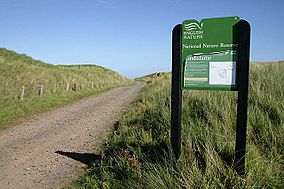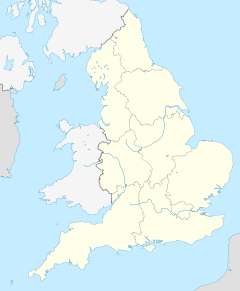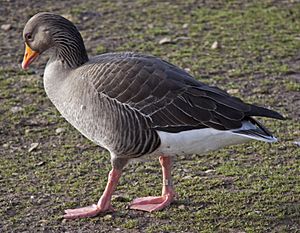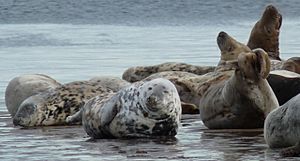Lindisfarne National Nature Reserve facts for kids
Quick facts for kids Lindisfarne National Nature Reserve |
|
|---|---|
 |
|
| Location | Northumberland, England |
| Area | 3,541 hectares (8,750 acres) |
| Natural England website | |
The Lindisfarne National Nature Reserve is a special protected area in the United Kingdom. It covers about 3,541 hectares (8,750 acres) of land and sea. This reserve was created to protect many important birds that spend their winters here.
Six types of wildfowl and wading birds from all over the world come here for the winter. For example, pale-bellied brent geese from Svalbard only come to this one place in the whole UK. Other bird visitors include pink-footed geese, greylag geese, wigeons, grey plovers, and bar-tailed godwits.
Contents
A Special Wetland Site
Lindisfarne National Nature Reserve is known as a Ramsar site. This means it is a wetland that is super important for nature around the world.
Amazing Habitats
The Lindisfarne National Nature Reserve protects a beautiful part of the coastline. This includes the sandy dunes of Lindisfarne (also called Holy Island). The reserve has many different types of coastal habitats. These include muddy areas that appear at low tide, rocky shores, sand dunes, and salt marshes. All these different areas are important for many plants and animals.
Plants of the Dunes
The sand dunes at Lindisfarne National Nature Reserve are home to many plants. Some, like early forget-me-nots and marram grass, grow close to the ground. They do not need much water to survive.
Insects and Snails
Many kinds of insects, moths, and butterflies love this environment. You might see 'woolly bears,' which are tiger moth caterpillars. Dark green fritillary and grayling butterflies enjoy the sun in July and August. Big brown-lipped snails can also be found here.
Beautiful Orchids
In early summer, the purple northern marsh orchid grows here. Its pink cousin, the early marsh orchid, also flourishes. In July, thousands of marsh helleborines bloom, creating amazing white carpets. A unique orchid, the Lindisfarne helleborine, was found on the island recently. Scientists discovered in 2003 that it was a new species. They named it Epipactis sancta.
Bird Life
Lindisfarne National Nature Reserve is very important for many bird species. These include the pale-bellied brent goose, wigeon, teal, pintail, merlin, dunlin, and bar-tailed godwit.
Migrating Birds
Because Lindisfarne is on the east coast, it is a great spot to see migrating birds. These birds arrive from the east, often from Siberia. You can see many redwings and fieldfares. Sometimes, rarer Siberian birds like yellow-browed warblers appear. Very rare birds like Radde's warbler, dusky warbler, and red-flanked bluetail have also been seen here.
As of 2016, 330 different bird species have been recorded on Lindisfarne and in the reserve. The large number and variety of birds make this area very popular with bird watchers. This is especially true in the autumn and winter.
Cuddy's Ducks
The common eider duck is often seen around Lindisfarne and the Farne Islands. Saint Cuthbert was said to love these ducks as pets. In 676, he made a rule to protect them. This is thought to be the first law ever made to protect birds! Locals still call these birds "Cuddy's ducks" or "Cuddy's hens" after Saint Cuthbert.
Seals
You can often spot grey seals in the water and on the rocks around Lindisfarne. Common seals are also seen here sometimes.
Visiting the Reserve
Lindisfarne National Nature Reserve is located on the North Northumberland coastline. It is about 10 miles (16 km) south of Berwick-upon-Tweed. You can find signs for Lindisfarne from the A1 highway south of Berwick-upon-Tweed. There are car parks on Lindisfarne (Holy Island), at Budle Bay, and at Beal on the mainland.
The Causeway and Safety
To get to Lindisfarne island, you must cross a causeway that is covered by the tide. It is very important for visitors to check the tide times and weather carefully. If you are unsure, ask for local advice. The road is usually open for about 3 hours after high tide until 2 hours before the next high tide. However, it might close for longer during stormy weather. If you plan to walk across the mud flats, the safe crossing time is shorter. Even with these warnings, about one car each month gets stuck on the causeway! Tide tables that show the safe crossing times are published by Northumberland County Council.
Volunteering at Lindisfarne
The Lindisfarne National Nature Reserve offers many chances to volunteer. Young people, seniors, and families can all help out. Volunteer activities include:
- Recording different animal and plant species.
- Helping to manage the habitats and the reserve land.
- Working as a site warden.
- Being a guide during special guided walks.





